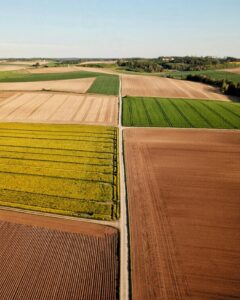
Guide To Soil And Septic For Land Buyers
Table of Contents
Imagine purchasing a piece of land for $50,000, closing the deal, and excitedly planning your dream home—only to realize later that you can’t build on it due to unsuitable soil conditions that prevent you from installing a septic system. Even worse, you find out that your $50,000 investment could be worth as little as $10,000, simply because you’re not able to install a septic system required to build a home on that property. This scenario is more common than you might think and underscores the significance of understanding soil and septic considerations when purchasing land.
Understanding the soil and how they impact your septic system might not be the most exciting part of land ownership, but it’s crucial for ensuring a successful and sustainable build. This is especially important given that nearly one-fifth of U.S. households—about 21 million homes—rely on onsite wastewater treatment systems, primarily septic systems, according to Circle of Blue. The reliance on septic systems is even more common in rural areas, where centralized sewer infrastructure is often unavailable.
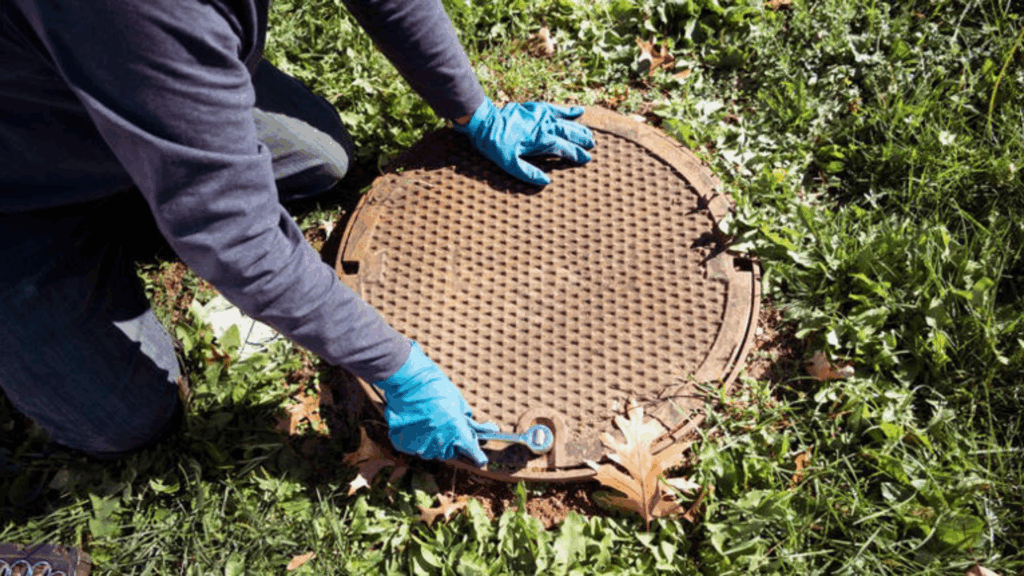
Why Soil and Septic Systems Matter for Land Buyers
Before purchasing land, it’s important to evaluate the soil and septic system potential. Failing to do so can lead to a cascade of problems that can derail your development plans and significantly impact your investment. Poor soil quality or inadequate septic systems can lead to:
- Failed building projects – Unstable soil can lead to foundation issues, while poorly draining soil can cause septic system failure, both resulting in costly repairs and construction delays. Repairing or replacing a failed septic system can be a significant financial burden.
- Expensive repairs or replacements – A malfunctioning septic system can require expensive repairs or even complete replacement, potentially costing tens of thousands of dollars.
- Health and environmental hazards – Untreated wastewater from a failed septic system can contaminate groundwater, posing risks to drinking water supplies and ecosystems.
- Legal and regulatory issues – Failing to comply with local septic system regulations can result in fines and legal complications.
Understanding Soil and Its Importance
The bottom line for land buyers is often: How does the soil affect my development plans and the value of my investment?
The answer lies in understanding how soil characteristics impact the feasibility and cost of installing a septic system, a crucial component for most residential and many commercial land uses. The characteristics of your soil can significantly impact the feasibility, cost, and functionality of your septic system, which in turn affects the overall value of your land and the success of your development plans.
1. Soil Conditions Required
To support a properly functioning septic system, your soil needs to meet certain criteria:
- Soil Type and Texture – The type of soil determines the type of septic system you can install and how well it will function. This is because different soil types have varying abilities to drain and filter wastewater. For example, sandy soils drain too quickly, potentially allowing contaminants to reach groundwater, while clay soils drain too slowly, leading to system backups. The ideal soil is loam, which offers a balance of drainage and filtration.
- Soil Depth – Adequate soil depth is essential for accommodating the septic system’s components, particularly the drainfield. The drainfield needs sufficient depth to allow for proper treatment and dispersal of wastewater, preventing contamination of groundwater and ensuring long-term system performance. Shallow bedrock or a high water table can limit the available depth and necessitate alternative septic system designs, which can be more expensive.
- Soil Drainage – Good drainage is crucial for preventing backups and ensuring the proper function of the septic system. Poorly drained soil can lead to system failure, requiring costly repairs and potentially posing health and environmental hazards.
2. Understanding the Financial Implications of Soil on Land Value
The quality of your soil can have a significant financial impact on your land investment. Here’s how:
A. Unsuitable Soil = Higher Costs & Lower Value – If your soil has poor drainage (like clay soil) or drains too quickly (like sandy soil), you may face:
- Increased installation costs – Needing a more complex septic system, such as a mound system or an aerobic treatment unit (ATU), can add tens of thousands of dollars to your initial expenses.
- Higher maintenance costs – Systems in unsuitable soils are more prone to failure, leading to expensive repairs and potential fines for environmental violations.
- Limited development potential – You may be restricted in the size and type of structures you can build, potentially impacting your long-term plans for the property.
- Decreased property value – Properties with significant septic limitations are less desirable, potentially reducing their resale value.
- Increased installation costs – Needing a more complex septic system, such as a mound system or an aerobic treatment unit (ATU), can add tens of thousands of dollars to your initial expenses.
B. Suitable Soil = Increased Value & Flexibility – Land with well-drained, loamy soil offers:
- Lower installation costs – A conventional septic system is typically sufficient, saving you thousands of dollars upfront.
- Greater development flexibility – You have more options for building and expanding on your property.
- Increased property value – Land with good soil for septic systems is more desirable and can command a higher price.
- Lower installation costs – A conventional septic system is typically sufficient, saving you thousands of dollars upfront.
By carefully assessing soil characteristics and their implications for septic systems, you can avoid costly mistakes, maximize development potential, and enhance the value of your land investment.
We are very pleased with the fair offer we received from Acrewell Land Company for our land. Alexander Reese and Marilag walked us through all aspect of the selling process, which made us feel more comfortable that we were making the right choice. I fully recommend this company to anyone who is considering selling their property to Acrewell.
I am absolutely delighted to write a glowing review for Acrewell's recent land purchase from us. The entire experience of transitioning the land ownership was incredibly smooth and efficient, thanks to Acrewell's exceptional professionalism and clear communication throughout the process.
Acrewell is awesome! I love the weekly updates. Marilag was very professional. She genuinely cared that my needs were met and questions answered. This has been a very easy transition. I highly recommend Acrewell.
Septic Systems 101: What Land Buyers Should Know
If your land isn’t connected to a municipal sewer system, you’ll need a septic system to treat and dispose of household wastewater. Here’s a breakdown of what you need to know:
1. How Septic Systems Work
A septic system treats wastewater on-site. It consists of a septic tank and a drain field. The septic tank separates solids from liquids, and the drain field filters the wastewater through the soil before it re-enters the environment. Proper soil drainage is critical for the system to function effectively. It typically consists of two main components:
A. Septic Tank: The Primary Treatment Unit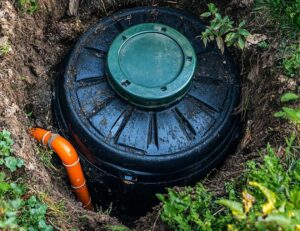
The septic tank is a watertight container, typically made of concrete or fiberglass, that receives all the wastewater from your home. It acts as the primary treatment unit, where solids settle to the bottom, forming a layer of sludge, and lighter materials, such as grease and oils, float to the top, creating a layer of scum. The middle layer contains partially clarified wastewater.
B. Drainfield (Leach Field): The Soil’s Role in Filtration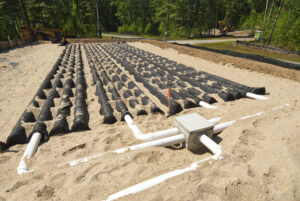
The partially treated wastewater from the septic tank flows into the drainfield, also known as a leach field. The drainfield consists of a series of underground trenches lined with perforated pipes. The wastewater is slowly released from these pipes into the surrounding soil. As the wastewater percolates through the soil, it undergoes further treatment. Soil particles filter out remaining solids, while microorganisms in the soil break down organic matter and remove harmful pathogens.
2. Soil Percolation Test
A percolation test, commonly known as a “perc” test, measures the soil’s ability to absorb water. This test is typically required for septic system permits and helps determine the size and design of your drainfield. A qualified professional will conduct the perc test by digging holes in the proposed drainfield area, filling them with water, and measuring the rate of water absorption. The perc test results are used to calculate the soil’s percolation rate, which is a key factor in determining the appropriate size and type of septic system.
3. Types of Septic Systems: Tailoring to Your Land
The type of septic system best suited for your property depends on a variety of factors, including soil characteristics, site conditions, local regulations, and your budget. Here are some common types of septic systems:
A. Conventional System – The conventional septic system is the most common type, consisting of a septic tank and a trench or bed drainfield. It relies on gravity to move wastewater from the septic tank to the drainfield. This system is typically suitable for properties with well-drained soils and a sufficiently deep water table. A conventional septic system is typically installed at a single-family home or small business. According to a study by the National Small Flows Clearinghouse (2018), conventional systems account for approximately 70% of all septic systems in the United States.

- Standard System (Gravel Trenches) – These are the traditional and most widely used type of conventional system and are common for homes with plenty of space and good soil drainage. . They consist of a series of trenches filled with gravel, with perforated pipes laid within the trenches to distribute the wastewater. The text on the image mentions that you need at least 36 inches of suitable soil depth for this type of system, and it gives a ballpark cost estimate of $6,500 to $8,500.
- Modified Conventional System (Chamber System) – Chamber systems are a more modern variation of the conventional system. Instead of gravel-filled trenches, they utilize prefabricated chambers that are connected to form a network for wastewater distribution. These chambers offer several advantages over gravel systems.. Chamber systems can be a good option for properties with limited space, as they often require less excavation than gravel systems. The cost of a chamber system typically ranges from $7,000 to $10,000, depending on similar factors as standard systems.
- Standard System (Gravel Trenches) – These are the traditional and most widely used type of conventional system and are common for homes with plenty of space and good soil drainage. . They consist of a series of trenches filled with gravel, with perforated pipes laid within the trenches to distribute the wastewater. The text on the image mentions that you need at least 36 inches of suitable soil depth for this type of system, and it gives a ballpark cost estimate of $6,500 to $8,500.
B. Panel Block System – This system offers a middle ground between the standard and chamber systems. It uses precast concrete panels to create the drainfield, which can be a good option if you have a smaller usable soil area but still have decent soil depth. It’s also a bit more robust than a standard gravel system. The cost for this type of system usually falls somewhere between $7,000 and $12,000.

C. Mound System – In areas with poor soil conditions, such as slowly permeable soils or a high water table, a mound system may be necessary. This system elevates the drainfield above the natural ground level using a mound of engineered soil. This raises the drainfield above any limiting layers. Mound systems are often used in areas with poorly drained soils, which account for approximately 10% of the land area in the United States (USDA NRCS, 2023). This can be a more expensive option, typically ranging from $10,000 to $20,000 or more.

D. Aerobic Treatment Unit (ATU) – This is the high-tech solution for wastewater treatment. An aerobic treatment unit (ATU) utilizes oxygen to enhance the breakdown of organic matter in the wastewater, making it a good choice for areas with sensitive environments or strict regulations. However, it comes with a higher price tag, often ranging from $15,000 to $30,000 or more.

4. Local Regulations
Familiarize yourself with the specific regulations and permitting requirements for septic systems in your area. Contact your local health department or building department to obtain this information. These regulations may dictate the types of systems allowed, minimum lot size requirements, setback distances from water bodies and property lines, and other crucial considerations. For example, some counties may require a minimum lot size of one acre for a conventional septic system, while others may have stricter regulations for properties located near sensitive water bodies (USEPA, 2002).
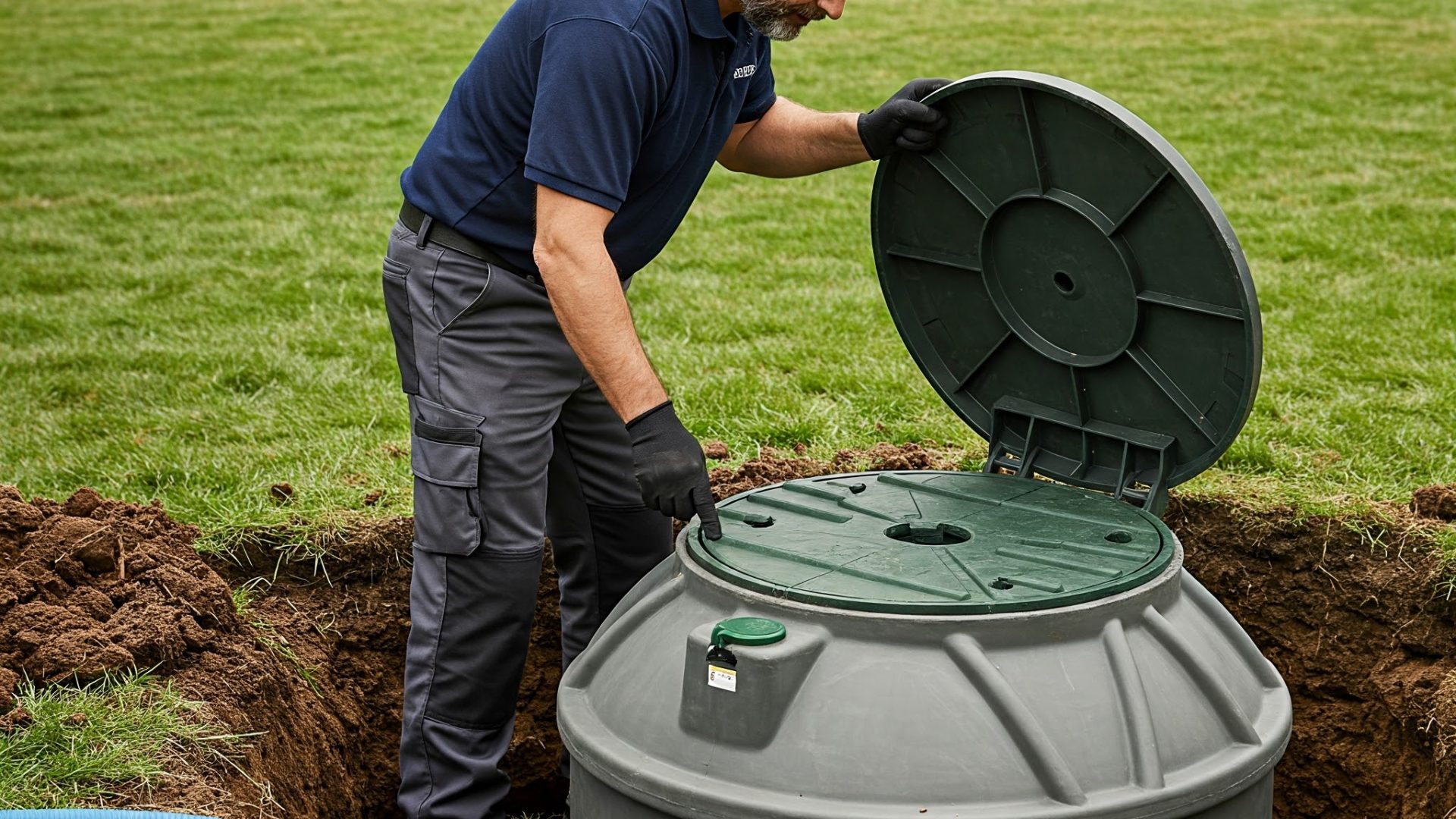
How to Evaluate Land for Soil and Septic Suitability
Before finalizing a land purchase, it’s essential to conduct thorough due diligence to evaluate its suitability for a septic system. This proactive approach can prevent costly surprises and ensure the long-term viability of your property. Here’s a step-by-step guide to assessing land before you buy:
Step 1: Research the Area
- Investigate the historical land use to identify potential soil contamination or drainage issues.
- Look for signs of erosion or flooding, which can indicate poor drainage or potential water table problems.
- Review publicly available soil surveys: The USDA Web Soil Survey provides detailed information about soil types and their limitations.
Step 2: Hire Professionals
- Engage a soil scientist or engineer to conduct Preliminary Soil Evaluation. It is an assessment that determines whether a property is suitable for a septic system. If the soil meets the necessary criteria, the property may qualify for a septic permit, allowing for system installation. However, if the soil is unsuitable, alternative solutions—such as engineered septic systems—may be necessary. This evaluation is crucial before purchasing land, as it provides an early indication of whether a septic system can be installed without expensive modifications.
- Consult a septic system installer for expert advice on appropriate septic system designs for your specific site conditions.
Step 3: Review Test Results
- Make sure the soil is suitable for your intended use, considering factors such as load-bearing capacity, drainage, and fertility.
- Confirm that the land can support a septic system if needed, evaluating the percolation rate, depth to water table, and depth to bedrock.
Step 4: Plan for Contingencies
- Budget for additional costs that may arise, such as soil amendments, alternative septic systems, or site preparation.
- Consider the long-term maintenance costs associated with your chosen septic system, including regular pumping and inspections.
Common Mistakes to Avoid
- Skipping soil and perc tests to save money – This can lead to costly surprises and project failures down the road.
- Ignoring local regulations and zoning laws – Non-compliance can result in fines and legal issues.
- Assuming all land is suitable for building or farming – Different soil types have different limitations and require specific considerations.
- Overlooking the cost of septic system installation and maintenance – Factor these expenses into your budget to avoid financial strain.
- Not knowing all setbacks that apply to your site plan.
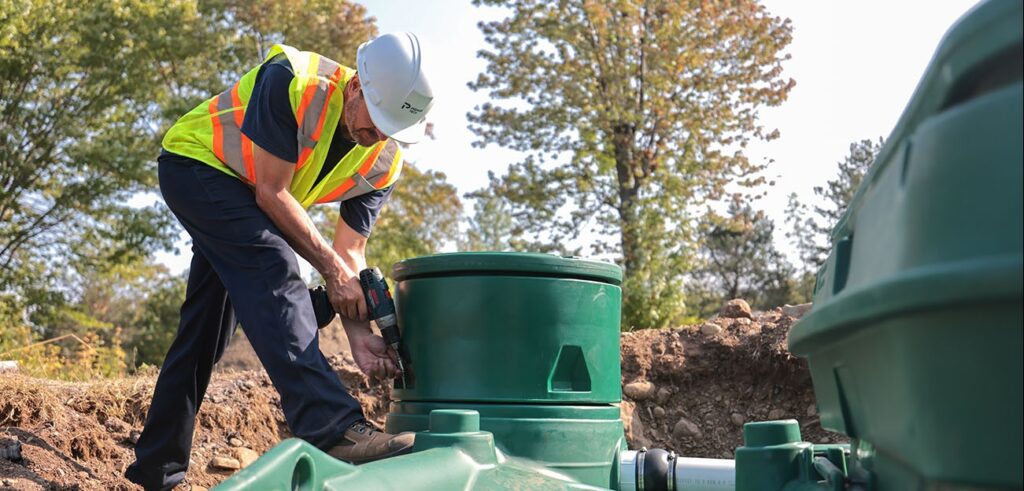
Conclusion
Understanding your soil and septic system is crucial for responsible land development and a successful homeownership experience. By conducting thorough due diligence, interpreting soil data, and following proper maintenance practices, you can lay the groundwork for a healthy and sustainable property.
Key Takeaways:
Soil characteristics significantly influence the suitability of land for septic systems.
Different types of septic systems exist, each with its own advantages and limitations. Selecting the appropriate system depends on various factors, including soil characteristics, site conditions, and local regulations.
Regular maintenance is essential to ensure the longevity and optimal performance of your septic system.
Consulting with qualified professionals can provide invaluable guidance throughout the land buying and development process.

Connect With Us
Please fill out the form below and we’ll be in touch.
Table of Contents
Post Categories
Latest Posts

Connect With Us Today!
Thinking About Buying Land? Let's Discuss Your Options!